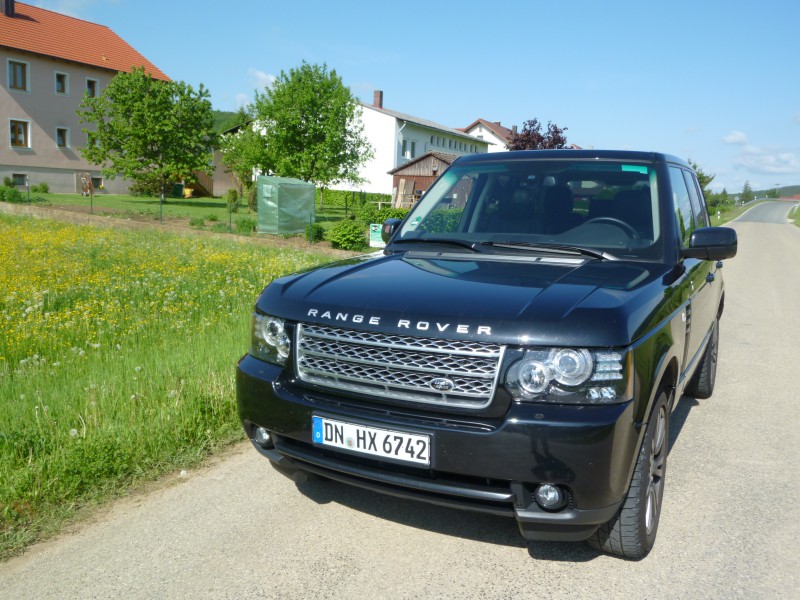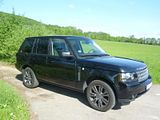
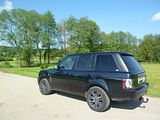
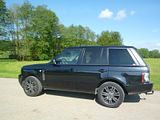
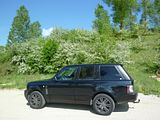
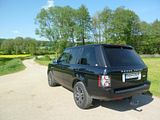
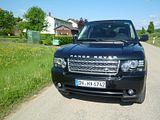
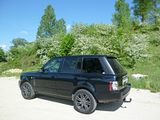
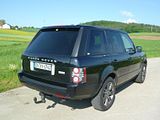
The Range Rover is one of those cars which really needs no introduction. When first launched, back in 1970, the concept of a large and costly off-road capable car was something of a novelty, with only the American Jeep Cherokee as any real sort of precedent. Although the early cars now seem rather utilitarian compared to what followed, the Range Rover quickly gained a reputation for being a comfortable cruiser, at home in town and country, capable of accommodating five adults and a pile of luggage, and driving briskly on all surfaces. Its maker was slow to realise the full potential, taking many years to increase the appeal with a five door model, an automatic gearbox, and more luxurious trim. But during the 1980s, finally, the car evolved in the way that its customers wanted, and sales continued to rise. The second generation model was launched in 1994, and ran for seven years. In its current third generation form, the Range Rover has been on sale since 2001 which is a long time. Indeed, this is far longer than just about any other design currently on the market. However, although the appearance has evolved only quite subtly in that time, it has undergone a number of updates. The most recent changes applied for the 2011 model year cars, when a 4.4 litre V8 diesel was slotted under the bonnet, replacing the former 3.6 litre unit, offering 15% more power and a quoted 19% reduction in fuel consumption. This followed the changes in late 2009, many of which were visual, with a new grille, side vents, revised headlamp design and a new interior incorporating not just the cylindrical gear selector seen in the Jaguar XF and XJ but also a new dashboard and upgrades to the equipment specification. It is a car that I have long admired, but certainly never had the opportunity to drive. Until now. Hertz at Munich Airport once again decided that the way to thank me for my continued loyalty was to make a generous upgrade from the car I had booked, and they took me by surprise when I found a 2012 model Range Rover Vogue with my name on it. Even though it was in the photographically challenging metallic black, there was no way I was going to reject this car. Full of anticipation, the question had to be whether it really is as good as everyone suggests.
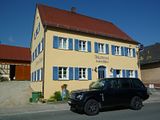
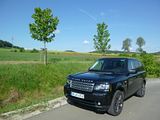


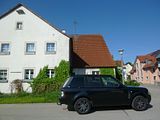

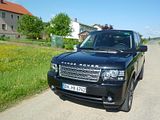

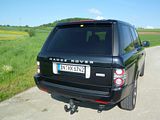
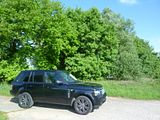


Although there have been diesel powered Range Rovers for a long time now, the early ones were best avoided, as the VM sourced oil burners under the bonnet were rather weedy and the cars were desperately slow. The memories of these cars were finally laid to rest when the third generation cars were launched, featuring a 6 cylinder BMW diesel. In 2007, this engine was later replaced by a Ford developed 3.6 litre V6 unit which put out 272 bhp, nearly 100 bhp more than the unit it replaced, and for sure expunged any memories of those earlier oil burners. Needing to keep up with the fast improving standards of competitors, and also to ensure Euro 5 compliance, the engine was updated and enlarged in late 2010, now with a 4.4 litre capacity, using parallel sequential turbochargers to help deliver the power smoothly. A smaller turbo chimes in beyond 2400 rpm, augmenting the medium sized variable geometry turbo that works at low revs. Range Rover is still available with a V8 petrol engine, nowadays supercharged to offer 503 bhp, which is nearly 200 bhp more than the 308 bhp delivered by the TDV8 unit. However, with 516 lb/ft available, the diesel has 55 lb/ft more torque than the petrol powerplant, and as the peak arrives at just 1500 rpm in the oil burner as opposed to 2500 rpm in the petrol car, the performance gap between the two models is nothing like as significant as used to be the case, and it is no surprise therefore to find that almost all sales in European markets are of the diesel car. You will still realise it is a diesel, just, but this is a very civilised unit, and definitely one that is refined enough to be in keeping with the car. Get in the Range Rover, and as long as the key is somewhere nearby, you just put your foot on the brake, and press the large “Start” button to the right hand side of the wheel, and the car fires. It is at this point that you will note that it is not a petrol engine, but it does not rattle like oil burners used to do. It is just that it has that characteristic noise that modern civilised diesels do. Once underway, there is no real trace of diesel noise, at all. There is ample evidence of diesel torque though, right through the rev range, from a very low speed. The transmission is a ZF supplied eight speed unit. Not that you would know, as despite listening very attentively, I was unable to count all the changes in ratio as the car accelerated away, so smooth is it. There is a “sport” mode as well as regular “drive”, but the gearbox is programmed to keep the revs relatively low and to rely on the prodigious levels of torque to help propel the Range Rover along. It works. I never had to push the throttle particularly hard even to get a burst of really rapid acceleration on busy autobahns, meaning that I was able to make serene progress regardless of whether I was travelling at 80 km/h or more than double that. On the move, the engine note is very subdued indeed. You do not get the V8 rumble at all, and in fact you can barely hear much more than a quiet murmur most the time, with a bit of wind noise an almost inevitable accompaniment thanks to the amount of air that has to be displace by a car of this sheer bulk. The official performance figures suggest that this 2.8 tonne car will get to 60 mph in 7.5 seconds, which although far from the fastest of the road is more than enough to ensure that you are not likely to be embarrassed on the road. There is a floor hinged organ pedal accelerator. Pushing it gently, and the Range Rover feels like it makes quite a sedate start from rest, but then it gathers momentum and you are left in little doubt that this car can be brisk if you want it to be. Many are even more likely to want it to be smooth, though, and it does this well. It is a splendidly refined cruiser, with low levels of noise, and I can imagine that this is the sort of car which, fully loaded, could cross half a continent with comfort and aplomb. You would not even need to stop that often to refuel it. I averaged 9.2 l/100 km in the 760 km that I drove the Range-Rover. That equates to 30.59 mpg, which is a really very impressive figure indeed for a car so large and heavy, and would have been unthinkable even for a diesel model Range-Rover only a few years ago.
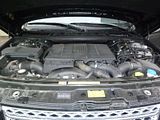
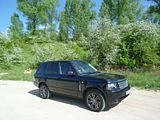
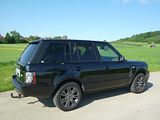
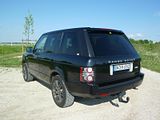
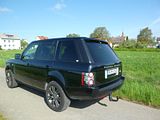

A large heavy car with a relatively high centre of gravity is not going to be the top pick for having some fun on the twisties, and I will admit that I did take the bends quite gently, fearful of getting into trouble that all the electronics would surely have sorted out. For sure, there are a lot of clever electronics in this car. Most of them are aimed at preserving the Range Rover’s legendary ability to cope with all manner of different surfaces, now called the Terrain Response off-road system. Hill Start Assist and Gradient Acceleration control have been added, which links the speed of descent to the throttle position even when Hill Descent Control is not engaged. There is also a Sand Launch Control function. There are lots of clever tricks to help on the road, too, with continuously variable multi-stage damping now fitted, replacing an earlier two stage system. Air suspension is standard. Although I was unable to test any of the off-road credentials, on road the car performed well. There is quite a bit of body roll, but the Range Rover felt like it was hanging on well on swooping bends. The steering is well weighted with good feel, and whilst not offering the sort of feel you would get in say a Ford Focus, it is precise enough that you can feel what the steered wheels are doing. The wheel had a lovely leather covering which made it very agreeable to hold. The ride is superlative, a benefit no doubt of that air suspension and the new adaptive damping as well as the extensive wheel travel which has always been a feature of the car to help it with off-road abilities. I did not take the car off the tarmac, but looking at it, it is clear that previous renters had got it muddy, and someone had clearly had an encounter with a hard object and tried to hide the slightly damaged wheel rim and tyre as the spare. The brakes proved quite soft to the touch, but as you pressed the pedal harder, then they came to life and made it clear that they would stop the car. There is an electronic parking brake in the centre console.
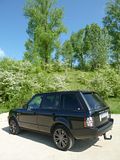
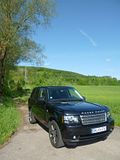
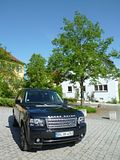
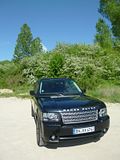
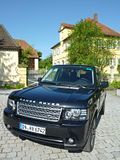
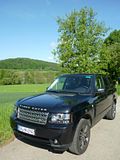
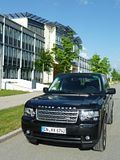

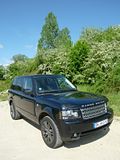

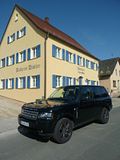
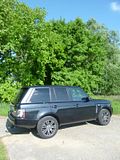
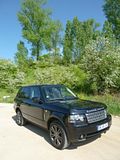
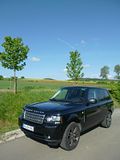
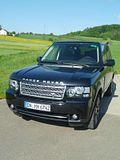
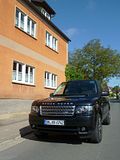
Despite the Range Rover’s size, it turned out to be not that daunting.to drive. The fact that you sit up higher than most other cars on the road certainly helps, as does the generous glass area. When you select reverse gear, the door mirrors drop and tilt to give a clear view of the kerbs. The test car had a very useful blind spot detection system which flashed an orange light in the corresponding door mirror when there was a car in the vicinity, and it also featured parking sensors all round, along with a reversing camera which projected a very clear image onto the satellite navigation screen. The camera has a “zoom in” function, which could prove useful especially in particularly tight spaces. Visibility over the shoulder is good and judging the back of the car is not hard, as you know that there is little beyond what you can see in the rear view mirrors. What worried me most was the height, and I concluded that trying to take this car into the underground car park at BMW Welt was perhaps not a good idea and so I managed to find an on-street space in which to park it. It was while there, near a Porsche Cayenne that you could easily see how much taller than this car is than the Porsche, itself not exactly a little car.

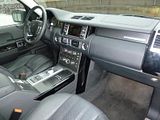
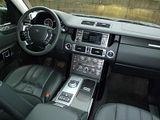
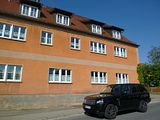
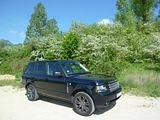

Open the door and look in the cabin, and you are greeted by the sight of a beautifully presented interior. The materials are all of good quality, and carefully selected so that everything looks cohesive and luxurious. The test car had gloss black trim inserts in the dashboard, door casings and the centre console which complement the soft feel leather which covers much of the dashboard, as well as the seats and the steering wheel. Look a little more carefully, and you realise that there appear to be no dials visible, and an awful lot of buttons. Push the “Start/Stop” button and the rather restful picture that covers the dormant instrument binnacle changes and two large dials with white markings on a black background for speedometer and rev counter with two smaller ones for fuel level and water temperature inset in the base of the large ones are presented. Two chunky stalks on either side of the column operate the indicators and wipers, with a smaller one on the left of the column which is the electrical adjustment for the steering column. The light switch is a rotary dial to the left of the column. Uppermost in the centre of the dash, you will find the neatly integrated display screen for the satellite navigation and audio unit functions, which rather cleverly can also double up as a tv screen for the passenger, at the same time. The screen is touch sensitive, and proved particularly easy to use. There are a few buttons on either side of the unit, but selecting a destination or changing a channel on the radio is all done on the screen, and is far easier than MMI or iDrive. The lower centre of the dash contains the series for the dual zone climate control for the front seat passengers, the controls for the heated seats and heated steering wheel and a small analogue clock. There are a series of buttons on the centre console which control the ride height of the air suspension, as well as the hill descent control and high/low range gearbox. A chunky lever for the electronic parking brake is mounted at an angle behind these switches. The traditional gearlever of earlier models has been replaced with the cylindrical selector which rises up when the engine is started. It proved very easy to use, as you just rotate the dial a couple of positions to go from forward to reverse. There are more buttons on the steering wheel boss, which are repeaters for many of the audio unit functions and the cruise control. There are paddles behind the wheel for the gearbox. Although there are lot of things to press and touch, it all proved pretty intuitive and well laid and logical. Only one thing seemed ergonomically sub-optimal and that is the block of switches for the electric windows which are mounted very high in the driver’s door and if you have the window open, you will find that by holding the switch down your hand almost gets in the way of the closing window. Rear seat passengers get their own controls for their climate control, which are on the rear face of the centre console
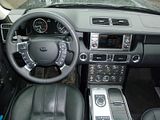
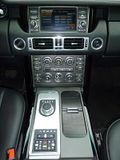
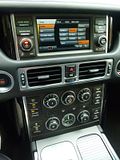
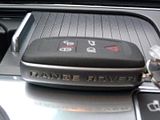

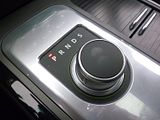
The good news continue when you look at the amount of space in the car. Thanks to the good ground clearance, it feels a bit like you have to clamber up into the passenger compartment. Once installed, though, what impresses most of all is the feeling of space. There is a large glass area, and with a glass sunroof in the test car as well, light floods into the cabin. The front seats have a full range of electrical adjustment, with a series of buttons mounted on the side of the seat along with the switches for three memory settings. The seat proved very comfortable. Passengers in the rear of the Range Rover should have few causes for complaint either, as they are also blessed with ample leg, shoulder and head room. The backrest angle can be adjusted. The rear seats are asymmetrically split, and the centre section can be folded forward to reveal a couple of lidded cup holders and a lidded stowage compartment. The boot area is large. The tailgate is split, with an electric release on the lower portion, but it is not always necessary to drop this piece down to be able to insert items, and the upper section goes down low enough that you do not feel like you are throwing things in the boot as is the case for cars such as the BMW X5. There is a rigid parcel shelf which is anchored firmly to either side of the boot, and which fold back in three sections. Removing it is not particularly easy, as you need to pull it out from the retaining guides. In addition to the regular shaped space, there are small compartments at either side of the boot which will hold items like the mandatory first aid kit. The rear seat backrests drop down, to extend the luggage area to make it truly vast. The resulting floor area is not completely flat, as the rear seat cushions do not lift up. Inside the cabin, there is a split level glovebox, though the top part is almost completely occupied by the CD auto changer unit, leaving just a small but deep area. The lower half is generously sized, though. There are pockets on all four doors, though those on the rear doors are not that large, and there is a reasonable sized cubby between the seats, though this does also house the iPod connector. There are pockets in the back of the rear seats. Twin cupholders are on the centre console, under louvred sliding covers, which could also be used as stowage areas.

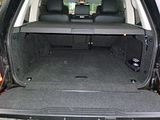


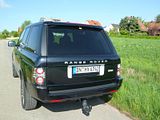
As Range Rover has moved steadily upmarket, so the available equipment levels have increased in line with the prices. The test car was badged Vogue, a trim level which is no longer offered in the UK. British market cars are currently available as the Westminster or the Autobiography, with a starting price of a few pounds under £70,000. Germany has both of these two trims as well as an “entry level” HSE and the Vogue. German market starting price for the HSE is €89,100, and the Vogue is priced from €96,900. The standard model is well equipped, but there is quite a long list of options and accessories that can be added to the car, as well as selecting from a range of sober metallic paint finishes, different interior shades from faun and beige to black for both the trim and the headlining as well as a number of wheel designs. Some of these will appeal more than others. The test car, in Sumatra Black metallic, black perforated Oxford leather upholstery and featuring the diamond-cut 20″ wheels was not quite to my taste, having something of the gangster look to it. Standard on the German spec Vogue are the electric sun roof, a 13 speaker 710 Watt Harman-Kardon surround sound audio system, adaptive lighting, and heated seats. These are in addition to features on the HSE which include a heated front screen, xenon lights, auto sensing lights and wipers, satellite navigation with the touch screen that doubles as a tv unit for the passenger, 6 CD auto changer, iPod and MP3 connectivity, the reversing camera, Upgrade to the Autobiography and most of the changes are ones of personal taste around different leather, more options for the interior trim, different alloy wheels, Westminster spec for UK models would appear to be broadly similar to the Vogue. There is no question that this is a luxury car, and it is trimmed and equipped accordingly.
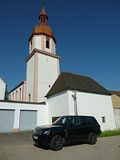
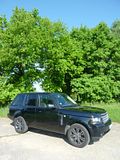
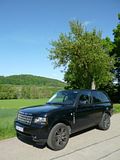
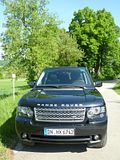
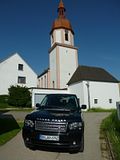

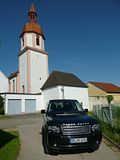
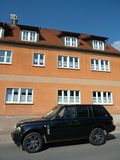
It is well known that a brand new Range Rover is a matter of months from launch. One of its priorities will be to reduce the weight of the car in an effort further to improve fuel economy and emissions performance. For sure, it will have other new capabilities and features and if Land Rover’s recent form is anything to go by, it will be a truly superlative vehicle. For those who cannot wait, though, or who are happy with a used example, the 2012 Range Rover is also a fabulous vehicle. Provided you can afford to buy it, fuel it and maintain it, and you can cope with its sheer size, an owner of one of these cars is unlikely to be disappointed. I certainly enjoyed my time with this car, and commend it highly.
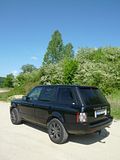
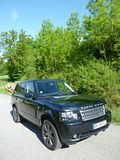
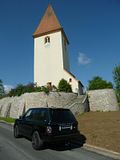

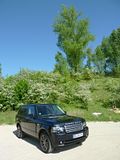
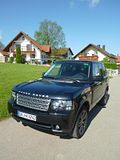

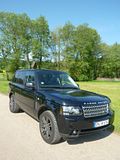
2012-05-18 18:16:43












































































